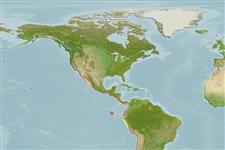>
Eupercaria/misc (Various families in series Eupercaria) >
Gerreidae (Mojarras)
Etymology: Diapterus: Greek, di = two + Greek, pteron = wing, fin (Ref. 45335).
More on author: Cuvier.
Issue
Considered as incertae sedis, in accordance with the general provisions for named-bearing types (Art. 67.2.5) of the ICZN (1999) (Ref. 75986:373-374).
Environment: milieu / climate zone / depth range / distribution range
Ökologie
seewasser demersal; tiefenbereich 1 - 30 m. Tropical; 32°N - 13°S, 114°W - 75°W
Eastern Pacific: Mazatlan, Mexico to Callao, Peru.
Size / Gewicht / Alter
Maturity: Lm ? range ? - ? cm
Max length : 35.0 cm TL Männchen/unbestimmt; (Ref. 124487); common length : 15.0 cm TL Männchen/unbestimmt; (Ref. 55763); max. veröff. Gewicht: 471.98 g (Ref. 124487)
Body diamond-shaped, compressed, and deep (depth contained 1.9 to 2.0 times in standard length); predorsal profile very compressed; mouth strongly protractile; preopercular border serrate; dorsal fin not notched to its base; second anal spine long and stout; body silver or gold with blue iridescent highlights; pelvic and anal fins yellow with dark rays (Ref. 55763).
Common in coastal waters. Juveniles inhabit lagoons of mangrove areas and tidal streams; adults are found over soft bottoms of deeper waters. May enter brackish waters (Ref. 37955). Feeds on benthic invertebrates and fishes. Its flesh is considered of good quality (Ref. 9303). Depth range assumed (RF).
Life cycle and mating behavior
Maturities | Fortpflanzung | Spawnings | Egg(s) | Fecundities | Larven
González-Acosta, A.F., P. Béarez, N. Álvarez-Pliego, J. De La Cruz-Agüero and J.L. Castro-Aguirre, 2007. On the taxonomic status of Diapterus peruvianus (Cuvier, 1830) and reinstatement of Diapterus brevirostris (Sauvage, 1879) (Teleostei: Gerreidae). Cybium 31(3):369-377. (Ref. 75986)
IUCN Rote Liste Status (Ref. 130435)
Bedrohung für Menschen
Harmless
Nutzung durch Menschen
Fischereien: kommerziell
Tools
Zusatzinformationen
Download XML
Internet Quellen
Estimates based on models
Preferred temperature (Ref.
123201): 21 - 28.5, mean 25.9 °C (based on 54 cells).
Phylogenetic diversity index (Ref.
82804): PD
50 = 0.5625 [Uniqueness, from 0.5 = low to 2.0 = high].
Bayesian length-weight: a=0.01318 (0.01065 - 0.01632), b=3.05 (2.99 - 3.11), in cm total length, based on LWR estimates for this species (Ref.
93245).
Trophic level (Ref.
69278): 3.7 ±0.2 se; based on diet studies.
Widerstandsfähigkeit (Ref.
120179): mittel, Verdopplung der Population dauert 1,4 - 4,4 Jahre. (Preliminary K or Fecundity.).
Fishing Vulnerability (Ref.
59153): Low vulnerability (25 of 100).
Nutrients (Ref.
124155): Calcium = 173 [85, 331] mg/100g; Iron = 1.06 [0.53, 2.08] mg/100g; Protein = 18.3 [16.3, 20.2] %; Omega3 = 0.179 [0.091, 0.344] g/100g; Selenium = 46.2 [23.1, 98.7] μg/100g; VitaminA = 14 [3, 46] μg/100g; Zinc = 1.02 [0.66, 1.58] mg/100g (wet weight);
